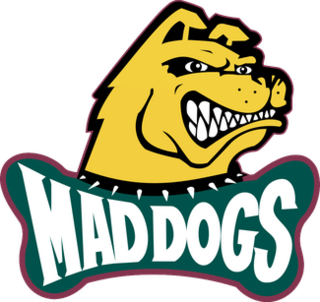
The Memphis Mad Dogs were a Canadian football team that played the 1995 season in the Canadian Football League. The Mad Dogs were part of a failed attempt to expand the CFL into the United States. They played at Liberty Bowl Memorial Stadium.

Simmons Bank Liberty Stadium, originally named Memphis Memorial Stadium, and later Liberty Bowl Memorial Stadium, is a football stadium located at the former Mid-South Fairgrounds in the Midtown area of Memphis, Tennessee, United States. The stadium is the site of the annual Liberty Bowl, the annual Southern Heritage Classic, and is the home field of the University of Memphis Tigers football team of the American Athletic Conference. It has also been the host of several attempts at professional sports in the city, as well as other local football games and other gatherings.
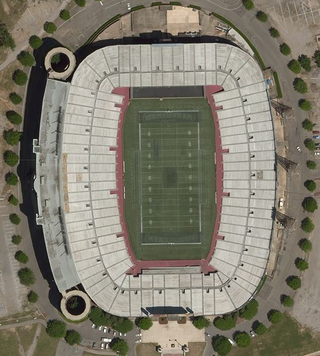
Legion Field is an outdoor stadium in the southeastern United States in Birmingham, Alabama, primarily designed to be used as a venue for American football, but occasionally used for other large outdoor events. Opened in 1927, it is named in honor of the American Legion, a U.S. organization of military veterans.

CEFCU ('sef-kyü) Stadium, formerly known as Spartan Stadium, is an outdoor athletic stadium on the west coast of the United States, located in the Spartan Keyes neighborhood of central San Jose, California. Owned by San José State University, the venue is the longtime home of Spartan football; it also hosts the university's commencement ceremony on Memorial Day weekend, and occasional high school football games. Known as Spartan Stadium for over eight decades, it was renamed in 2016.
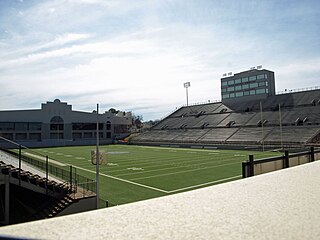
Cramton Bowl is a 25,000-seat stadium located in Montgomery, Alabama. Cramton Bowl opened in 1922 as a baseball stadium and has been home to Major League Baseball spring training and to minor league baseball. Today, however, its primary use is for American football.

FirstBank Stadium is a football stadium located in Nashville, Tennessee. Completed in 1922 as the first stadium in the South to be used exclusively for college football, it is the home of the Vanderbilt University football team. When the venue was known as Vanderbilt Stadium, it hosted the Tennessee Oilers during the 1998 NFL season and the first Music City Bowl in 1998 and also hosted the Tennessee state high school football championships for many years.

Pat Dye Field at Jordan-Hare Stadium is an American football stadium in Auburn, Alabama on the campus of Auburn University. It primarily serves as the home venue of the Auburn Tigers football team. The stadium is named for Ralph "Shug" Jordan, who owns the most wins in school history as a head coach, and Cliff Hare, a member of Auburn's first football team as well as Dean of the Auburn University School of Chemistry and President of the Southern Conference. On November 19, 2005, the playing field at the stadium was named in honor of former Auburn coach and athletic director Pat Dye, giving the venue the moniker Pat Dye Field at Jordan-Hare Stadium.

Amon G. Carter Stadium is an open-air football stadium on the campus of Texas Christian University in Fort Worth, Texas. It is the home stadium of the TCU Horned Frogs football team. It is named after Amon G. Carter, a prominent Fort Worth businessman, newspaper publisher, and city booster. Amon G. Carter stadium has several popular nicknames, the most popular being "The Carter" and "Hell's Half Acre".

David Booth Kansas Memorial Stadium is a college football stadium in Lawrence, Kansas, on the campus of the University of Kansas. The stadium was opened in 1921, and is the seventh oldest college football stadium in the country, and is widely recognized as the oldest west of the Mississippi River. It is the home stadium of the Kansas Jayhawks football team.
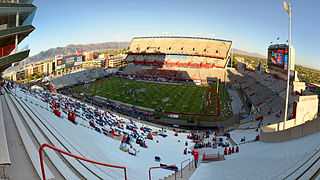
Arizona Stadium is an outdoor college football stadium in the southwestern United States, located on the campus of the University of Arizona in Tucson, Arizona. It is the home field of the Arizona Wildcats of the Big 12 Conference.

Centennial Bank Stadium is a football stadium located in Jonesboro, Arkansas, on the campus of Arkansas State University that is home to the Arkansas State Red Wolves football team. The stadium opened in 1974 as Indian Stadium named after the old nickname of the school, the Indians, until the 2007 season when it was renamed ASU Stadium. The venue was renamed Liberty Bank Stadium in September 2012 after Liberty Bank of Arkansas donated approximately $5 million to the university. In 2013, Liberty Bank was bought by Home BancShares, whose trade name is Centennial Bank. Since 2015, the stadium has a seating capacity of 30,406.

Charles M. Murphy Athletic Center is the name of the main athletic department building at Middle Tennessee State University in Murfreesboro, Tennessee. The building opened December 11, 1972, and is named in honor of former athletics director Charles M. "Bubber" Murphy, a standout athlete at the college in the 1930s, who also served as head coach of Middle Tennessee State's football (1947–1968), basketball (1948–1949), and baseball programs.

Cessna Stadium is a stadium on the campus of Wichita State University in Wichita, Kansas, United States. It opened in 1946 and served as the home of the football team until the program was discontinued in 1986. It is currently home of the Wichita State Shockers track and field team. The Kansas Board of Regents approved demolition of the stadium in April 2020. Only the east stands were demolished. The rest of the stadium is supposed to be demolished after the 2024 track and field season.

Bristol Municipal Stadium, also referred to as the Stone Castle, is an athletic facility located on the campus of Bristol Tennessee High School in Bristol, Tennessee. The structure features a design that is reminiscent of Medieval Gothic architecture and has a seating capacity of approximately 8,000. The stadium currently serves as the home field of the football team of Tennessee High School. The structure was added to the National Register of Historic Places in 1987.
Russwood Park was a stadium in Memphis, Tennessee. It was primarily used for baseball and was the home of the Memphis Chicks, the Negro American League Memphis Red Sox, and the Memphis Red Sox minor league baseball team until the spring of 1960. The ballpark was originally built in 1896 and was known as Elm Wood Park or Red Elm Park. In 1915, team owner Russell E. Garner incorporated his name into the ballpark's name. The "wood" part of the name would figure into its demise.

Memorial Stadium was a multi-purpose stadium in Kent, Ohio, United States, on the campus of Kent State University. Its primary use was as the home field for the Kent State Golden Flashes football team and also served as the home venue for the KSU men's track and field team. The football and track teams had already been playing on the site since 1941, but with temporary bleachers for seating. The permanent grandstand built and dedicated in 1950, which also included a press box, was the first phase of the stadium, and was later followed by a duplicate grandstand on the opposite side of the field in 1954. Initial plans called for the seating to eventually surround the field, though these plans were largely never realized. During the 1960s, additional bleacher seats were added separate from the two main grandstands on all sides of the field, and brought seating capacity to approximately 20,000 by 1965.
The Memphis Tigers football team represents the University of Memphis in college football in the NCAA Division I Football Bowl Subdivision. The Tigers play in the American Athletic Conference as an all-sports member. They play home games at Simmons Bank Liberty Stadium. The team's head coach is Ryan Silverfield. Since their inaugural season in 1912, the Memphis Tigers have won over 500 games and appeared in seventeen bowl games.
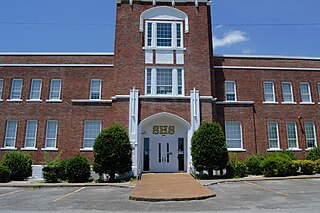
Sweetwater High School is a four-year public high school in Sweetwater, Tennessee operated by Monroe County Schools.
The 1943 Southwestern Louisiana Bulldogs football team was an American football team that represented the Southwestern Louisiana Institute of Liberal and Technical Learning as a member the Louisiana Intercollegiate Conference during the 1943 college football season. The Louisiana Intercollegiate Conference has no league play in 1943 because of World War II. Led by second-year head coach Louis Whitman, the Bulldogs compiled a record of 5–0–1, and outscored their opponents 172 to 40. In the Oil Bowl, Southwestern Louisiana defeated Arkansas A&M on a muddy field, a team that had tied them 20–20 earlier in the season. The Bulldogs played their home games at McNaspy Stadium in Lafayette, Louisiana.















